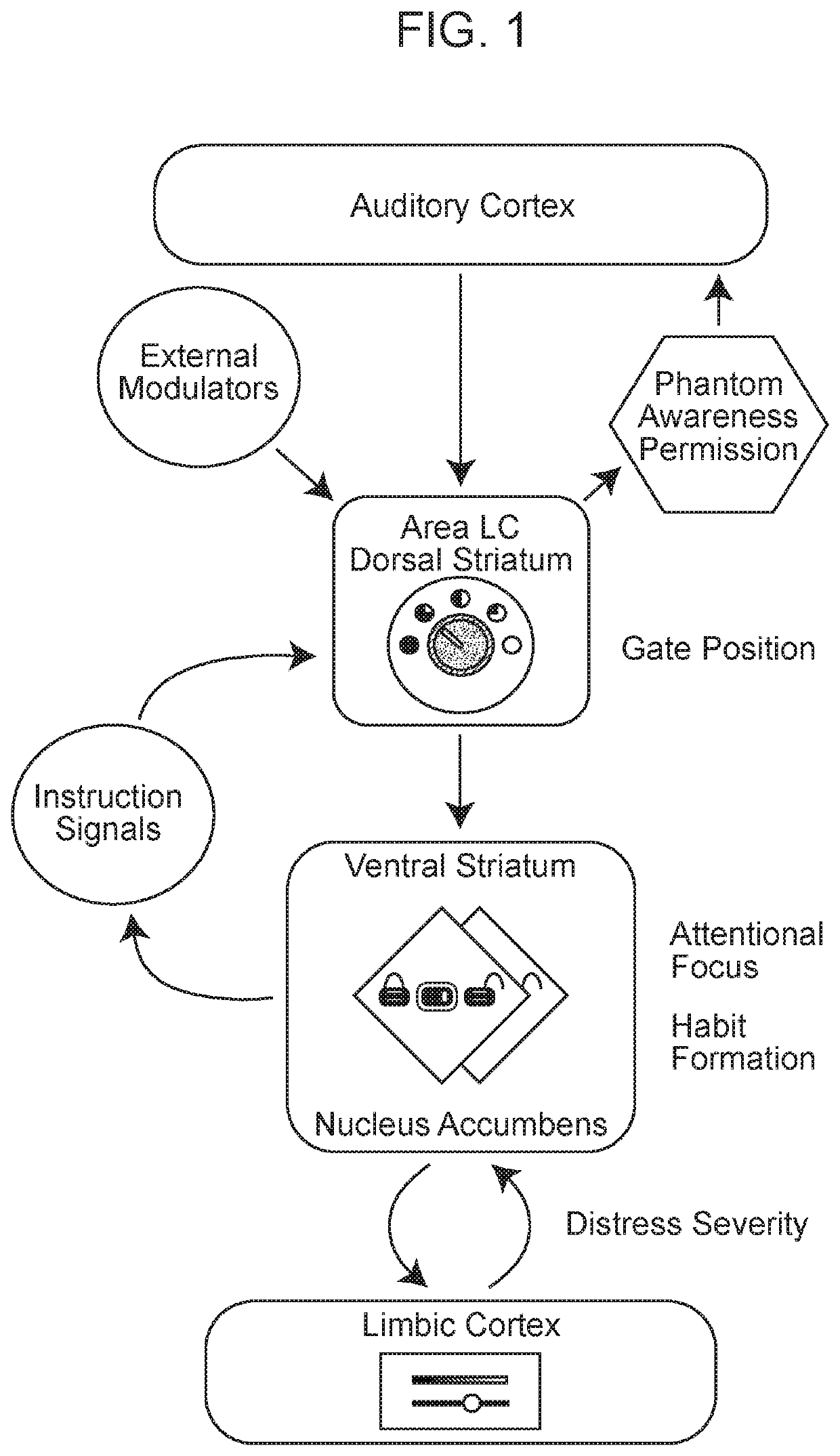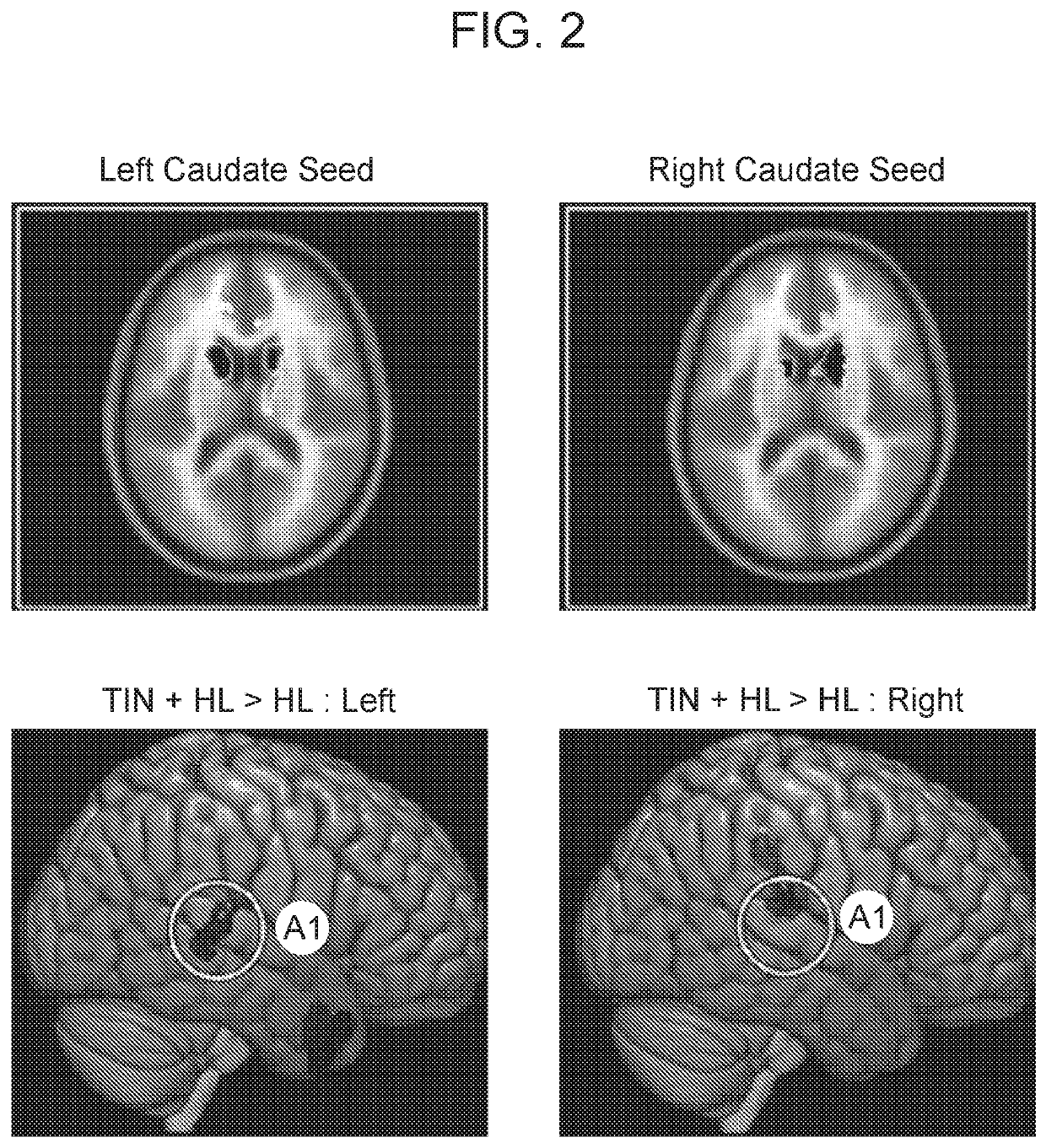Multimodal Neuroimaging-Based Diagnostic Systems and Methods for Detecting Tinnitus
a neuroimaging and diagnostic system technology, applied in the field of multimodal neuroimaging, can solve the problems of increasing the risk of persistent auditory phantoms triggered by hearing loss, increasing and reducing the loudness of tinnitus, so as to reduce the risk of hearing loss and tinnitus. the effect of modulating megi functional connectivity
- Summary
- Abstract
- Description
- Claims
- Application Information
AI Technical Summary
Benefits of technology
Problems solved by technology
Method used
Image
Examples
example 1
Striatal Gate Model
[0321]A diagnostic tool for detecting Tinnitus can be based on the following anchoring features of the striatal gate model (FIG. 1): instruction on details of phantom percepts are represented in the central auditory system, permission to gate candidate phantom percepts for conscious awareness is controlled by the dorsal striatum, action to attend, reject or accept phantom percepts, and form perceptual habits is decided by the ventral striatum, and determination of tinnitus distress severity is mediated through the limbic and paralimbic system-nucleus accumbens-ventral striatum loop.
[0322]Predictions arising from the striatal gate model are evaluable by multimodal neuroimaging and interventional neurostimulation methods. The latter include direct electrical (DBS), external magnetic (deep transcranial), external ultrasound (MRI guided ultrasound), and destructive lesion (GammaKnife) approaches. As such, the following anchoring features may be evaluated: 1) chronic t...
example 2
Caudate-Cortical Connectivity fMRI Differentiation Feature
[0323]At the cohort level, it has been demonstrated that caudate nucleus subdivision specificity of increased corticostriatal connectivity in chronic tinnitus. The striatal gate model was tested to examine the roles of auditory and auditory-limbic networks in chronic tinnitus noninvasively by comparing resting-state fMRI functional connectivity patterns in tinnitus patients against controls. Resting-state functional connectivity of the caudate dorsal striatum (area LC), caudate head (CH), nucleus accumbens (NA), and primary auditory cortex (A1) were tested to determine patterns of abnormal connectivity (Hinkley et al 2015 Front Hum Neurosci).
[0324]A comparison of chronic tinnitus patients adjusted for hearing loss levels with matched control subjects and normal hearing showed increased coherence between area LC and ipsilateral auditory cortical fields of the middle temporal gyrus (MTG) and superior temporal gyrus (STG). Incre...
example 3
fMRI and MEGI in Subjects with and without Tinnitus
[0325]fMRI cohort contrast studies that controlled for hearing loss level (moderate and unilateral profound hearing losses) to differentiate between tinnitus and no-tinnitus subjects showed nearly identical resting-state functional connectivity patterns. Intraoperative caudate nucleus stimulation experiments revealed caudate subdivision specificity of tinnitus modulation responses. fMRI study in moderately severe tinnitus subjects to contrast caudate head versus caudate body functional connectivity with auditory cortex confirmed the caudate body to be a more promising differentiation feature candidate. MEGI showed the left frontal gyrus to be correlated with tinnitus distress magnitude and increased latency of the peak M100 response to a 1 kHz tone differentiated chronic tinnitus subjects from controls. Those observations support the development of a multimodal neuroimaging-based objective tool to detect tinnitus that would be appli...
PUM
 Login to View More
Login to View More Abstract
Description
Claims
Application Information
 Login to View More
Login to View More - R&D
- Intellectual Property
- Life Sciences
- Materials
- Tech Scout
- Unparalleled Data Quality
- Higher Quality Content
- 60% Fewer Hallucinations
Browse by: Latest US Patents, China's latest patents, Technical Efficacy Thesaurus, Application Domain, Technology Topic, Popular Technical Reports.
© 2025 PatSnap. All rights reserved.Legal|Privacy policy|Modern Slavery Act Transparency Statement|Sitemap|About US| Contact US: help@patsnap.com



